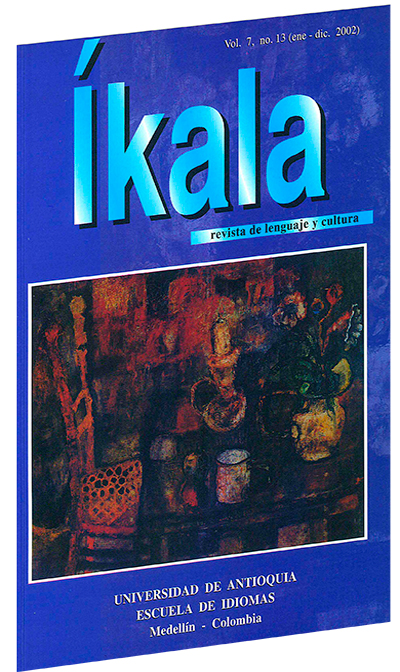Internet en la didáctica de las lenguas extranjeras: un paso adelante
DOI:
https://doi.org/10.17533/udea.ikala.3209Keywords:
internet, teaching of foreign languages, TICsAbstract
In the last few years the number of teachers using Technology Enhanced Language Learning (TELL) has increased and numerous articles have been written about the role of technology in foreign language teaching. The most rapidly developing innovations in the area of TELL are happening in relation to the Internet, used not only as a learning tool but also as a real field of language learning with varied, exponentially expanding resources.The purpose of this contribution is to explore the role that the Information and Comunication Technologies (ICT) have and will have in the way foreign languages are taught and learnt.
Received: 06-06-02/ Accepted: 28-08-02
How to reference this article:
Casanovas Català, M. (2002). Internet en la didáctica de las lenguas extranjeras: un paso adelante. Íkala. 7(1), pp. 53 – 60
Downloads
References
Bartolomé Piña, A., 1996, “Preparando para un nuevo modo de conocer”, Edutec. Berwald,
J. P., 1987, “Teaching foreign languages with realia and other authentic materials”, ERIC Clearinghouse on Languages and Linguistics. (ERIC Document Reproduction Service No. ED 289 367) Washington, DC.
Casanovas Catalá, M., 2001, “El currículum de inglés: algunas propuestas desde las tecnologías digitales”, Aula de Innovación Educativa, 105, 21- 24. Castells, M., 1996, The Rise of the Network Society, Cambridge, Mass., Blackwell. ________, 1997, La era de la información. Economía, sociedad y cultura. Vol. 1. La sociedad red, Madrid, Alianza.
Dudeney, G., 2000, The Internet and the language classroom, Cambridge, Cambridge University. Figueras, N. et al., 2000, “English and the new technologies”, APAC of News (Proceedings of ELT Convention 2000), 39.
Grabe, M. y Grabe, C., 1992, Integrating technology for meaningful learning, Boston, Houghton Mifflin.
Guitert, M., 2001, “Los entornos de enseñanza y aprendizaje virtuales en las puertas del siglo XXI”, 35-50.
Lévy, P., 1997, Cyberculture, Luxembourg, Éditions Odile Jacob/Éditions du Conseil de l’Europe.
Monereo, C., 2001, “Ser estratégico y autónomo aprendiendo”, Aula de Innovación Educativa, 100, 5-9.
Smith, B., 1997, "Virtual Realia", The Internet TESL Journal, 3, (7), jul., URL: http:// www.aitech.ac.jp/~iteslj/Articles/SmithRealia.html
Trenchs Parera, M., 1998a, E-mails a una mestra. Correu electrònic i aprenentatge de llengües. Lleida: Pagès Editors.
______, 1998b, “Computers and communication in the classroom: learning to write in a foreign language”, Revista Española de Lingüística Aplicada, 13.
______, 2001. Nuevas tecnologías para el autoaprendizaje y la didáctica de lenguas. Lleida: Milenio.
Warschauer, Mark/Healy, Deborah, 1998, “Computers and language learning: an overview”, Language Teaching, 31, S.57-71.
Downloads
Published
How to Cite
Issue
Section
License
Copyright (c) 2002 Íkala, Revista de Lenguaje y Cultura

This work is licensed under a Creative Commons Attribution-NonCommercial-ShareAlike 4.0 International License.












